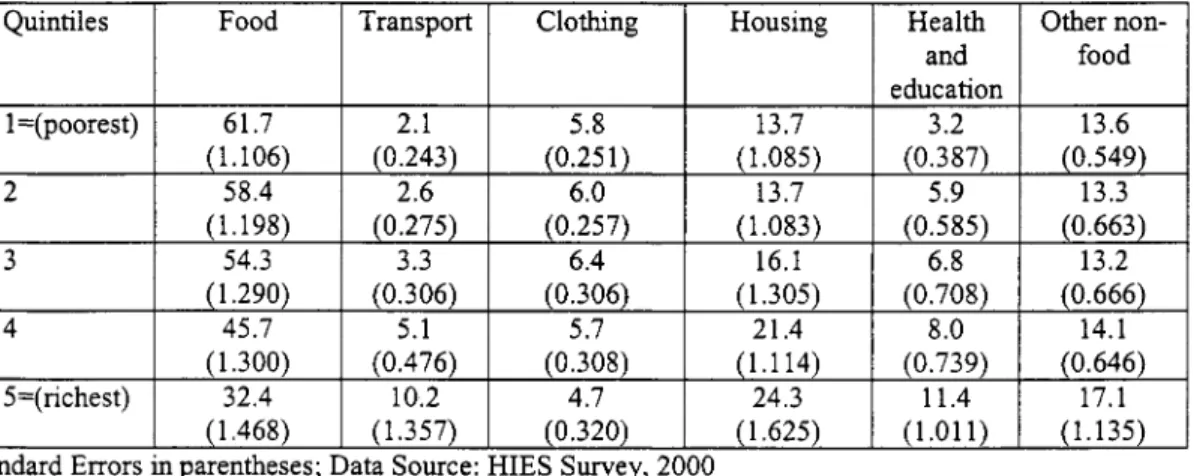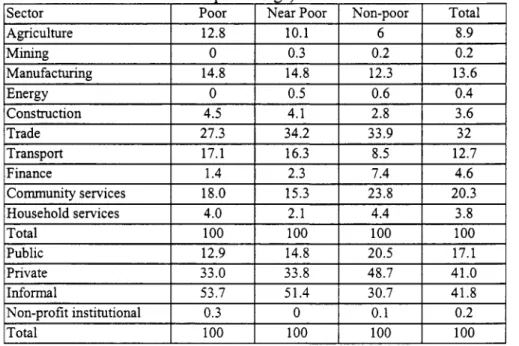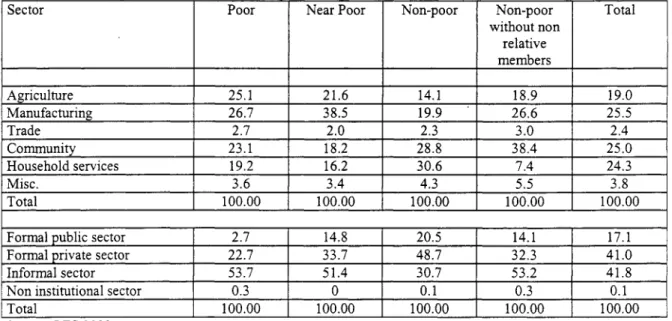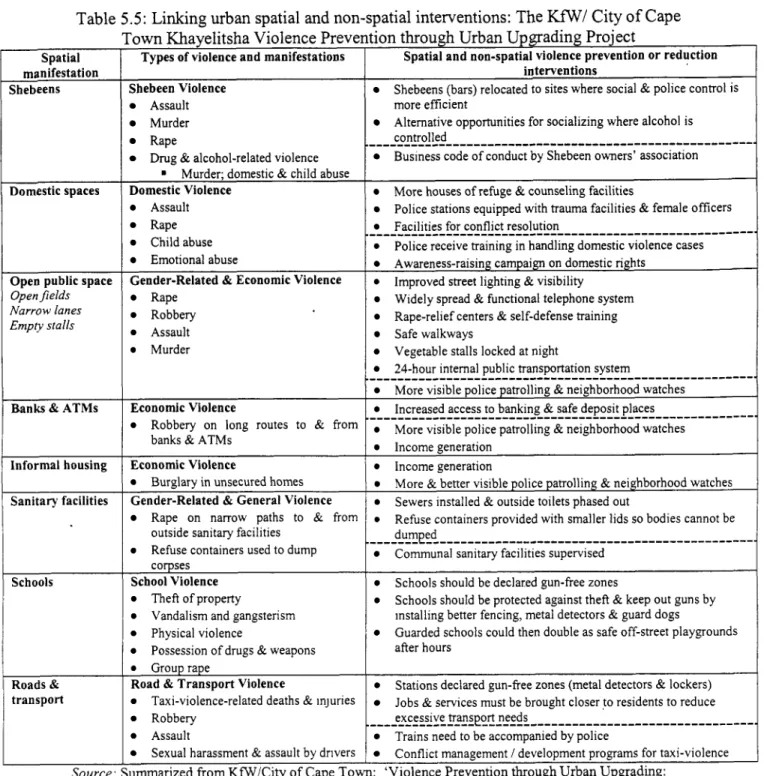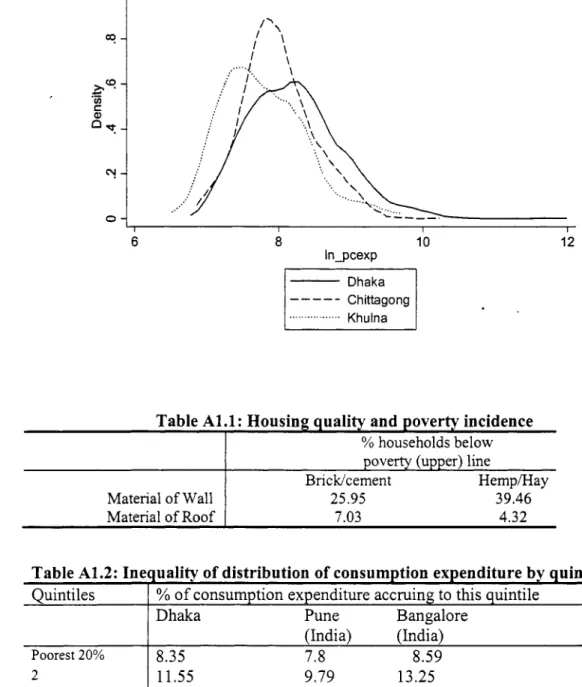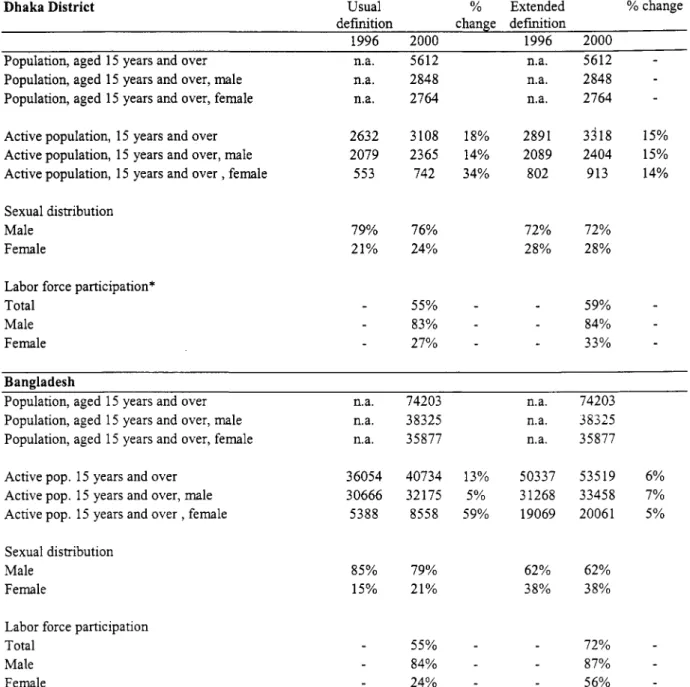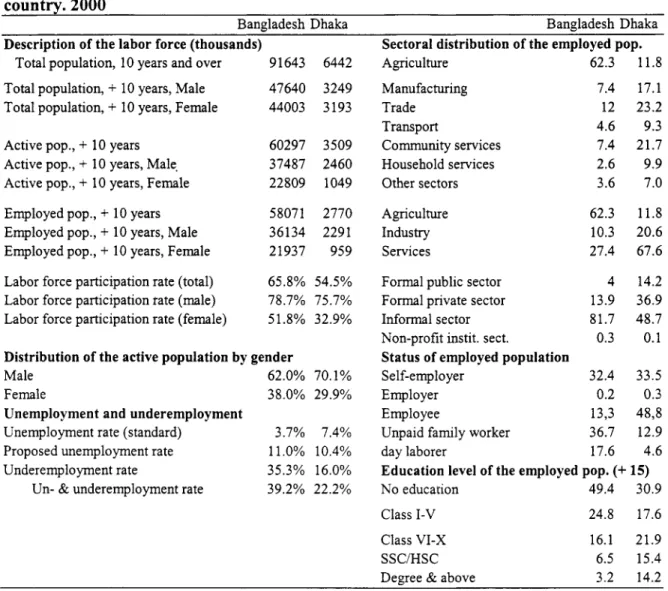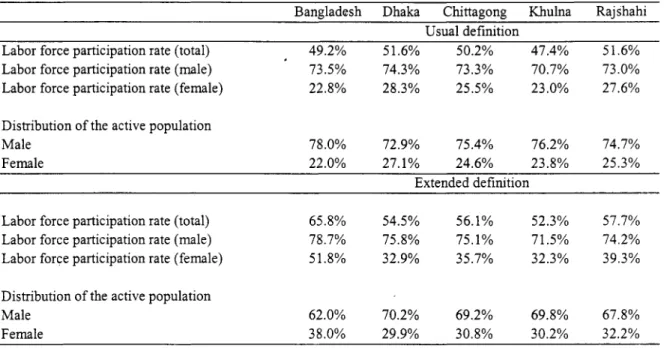April 16, 2007
Document of the World Bank
Report No. 35824-BD Bangladesh Dhaka: Improving Living Conditions for the Urban Poor
Report No. 35824-BD
Bangladesh
Dhaka: Improving Living Conditions for the Urban Poor
Sustainable Development Unit South Asia Region
Public Disclosure AuthorizedPublic Disclosure AuthorizedPublic Disclosure AuthorizedPublic Disclosure Authorized
Preface and Acknowledgements
This report was prepared by a team led by Judy L. Baker (World Bank, FEU).
Team members who participated in the field work and contributed background papers commissioned for this report include: Nazrul Islam, (University o f Dhaka and Centre for Urban Studies), “Dhaka Land and Housing”, Somik Lall, (World Bank, DECRG), “A Poverty Profile for Dhaka”; David L e Blanc and Robert Buckley (World Bank, TUDUR),
“Dhaka Urban Poverty: Land and Housing Issues”; Bernice Van Bronkhurst (World Bank, L A C Region), “Crime and Violence”, Sabina Faiz Rashid (BRAC University) and Yasmeen Hossain (London School o f Economics), “Constraints to Delivering Services to the Urban Poor Living in Slums in Dhaka, Bangladesh”, Claire Salmon, (University o f Savoie, France), “The Situation o f the Poor in the Working Population o f Dhaka.”, This study also drew on independent work camed out by Rashid and Mannan, 2004, “The Heterogeneity o f the Urban Poor: Political-Economy and Social Conditions in Urban Slums” and Aparajeyo, 2002 “Slum Observatory Survey.”
Surveys that were commissioned for this study were carried out by Aparajeyo (Crime and Violence), and the Local Government Engineering Department (LGED), (Spatial Poverty Mapping o f the Dhaka Metropolitan Area). Data analysis was done by Asha Sundaram and Jonny Anderson. The Coalition for the Urban Poor (CUP) assisted greatly in organizing meetings with its members and with local communities.
The work was carried out under the guidance o f Sonia Hammam, Sector Manager, (SASEI) and Christine Wallich, Country Director for Bangladesh. The team benefited from comments from the two peer reviewers, Christine Kessides and Hassan Zaman, as well as from Patricia Annez, Enrique Pantoja, Jaehyang So, Catherine Tovey, and Nilufar Ahmed. The report also benefited greatly from the inputs received from participants at the Consultation Workshop which discussed the findings o f the report extensively on Fibruary 14 and 16, 2006.
Table of Contents
Executive Summary ... iv
Chapter 1: A Poverty Profile for Dhaka ... 1
I . Introduction ... 1
I1 . Poverty and Inequality in Dhaka ... 2
I1 . Charactenstics o f the poor ... 6
I11 Perceptions o f Poverty 9 Chapter 2: Employment and Poverty ... 13
I . Introduction ... 13
I1 . General Characteristics o f the Labor Force in Dhaka ... 13
. I11 . Employment and the Poor ... 14
A . . General characteristics ... 15
B . Employment Sector and Occupation ... 16
C . Gender. employment and poverty ... 19
D . Participation of children in the labor force ... 20
E . Working hours and income ... 21
F . Un- and underemployment ... 21
I V . Prospects for Employment Generation and Policy Recommendations ... 22
A . Trends and prospects on the supply side of Dhaka’s labor market ... 22
B . Trends and prospects on the demand side of Dhaka’s labor market ... 27
V . Improving income earning opportunities for the poor ... 31
I . Background ... 33
A . A Fast Growing. Poor Megacity ... 33
B . High Land Prices Have Excluded the Poor from Ownership of Land and . . . ... Chapter 3: Shelter for the Poor ... 33
Housing ... 35
I1 . Main policy constraints ... 37
A . Unresponsiveness toprice signals for a large portion of the land in the city ... 37
B . An enabling housing policy without enablers ... 39
C . Failures of coordination and services at the local level ... 44
D . The limited role of NGOs in housing for urban poor ... 45
I11 . Improving Shelter Conditions for the Urban Poor ... 46
Chapter 4: The Challenges o f Service Delivery for Dhaka’s Poor ... 50
I . The Current Situation ... ... 50
A . Basic Services ... 51
B . Service Providers ... 52
I1 . Constraints to Service Delivery ... 55
A . Lack ofgovernment policy ... 55
B . Evictions of slum residents ... 55
C . The Pervasive Role of Mastaans ... 56
D . Other constraints ... 56
I11 . Improving Service Delivery for the Urban Poor ... 58
Chapter 5: Crime and Violence and the Urban Poor ... 61
I1 . Manifestations o f crime and violence affecting the urban poor in Dhaka ... 62
A . Main Survey Findings ... 63
I . Background and Introduction ... 61
I11 . Relationship between crime and violence and social. institutional. and legal issues
... 70
IV . Addressing Crime and Violence ... 72
SpeciJic recommendations for crime and violence prevention in Dhaka ... 73
References ... 80
List o f Boxes Box 2.2: Post MFA and entry o f China in the WTO. their impact on the poor in Dhaka? A summary o f the literature ... 29
Box 3.1 : Slum ImprovemenWpgrading Programs o f the National Government ... 43
Box 3.2: NGO programs targeted to poor renters ... 46
Box 4.1 : Making Things Work in Health Care ... 54
Box 4 . 2: Case Study from CUS: Slum Eviction in Agargaon ... 56
Box 4.3: Making Things Work in Water and Sanitation ... 57
Box 4.4: Case Study: Lessons Learned from DSK’s Water Delivery Project in Conjunction with DWASA ... 60
Box 5.1 : Community Police Stations in Mumbai’s slum ... 78
Box 5.2: Crime and Violence Prevention Components in Bank-financed Integrated Slum Box 2.1: The “missing” women in the poor income groups ... 18
Upgrading Operations: ... 79
List o f Tables Table 1.1: Slums covered in the Aparajeyo Survey ... 2
Table 1.2: Characteristics o f the poor in Dhaka ... 6
Table 1.3: Distance to Public Services for Slum Dwellers (in meters) ... 8
Table 1.4: Percentage of total (monthly) household expenditure in Takas for Dhaka S M A ... 9
Table 2.1 : Employment Characteristics o f Households by Income Group ... 16
Table 2.2: Sectoral distribution o f the male workers in Dhaka SMA by income group (in Table 2.3: Main Jobs of Male Workers in Dhaka ... 17
Table 2.4: Sectoral distribution o f female workers in Dhaka SMA by income group (in Table 2.5: Main Jobs of Poor Female Workers ... 19
Table 2.7: Unemployment and Underemployment in Dhaka SMA by Income Group .... 22
Table 2.8: Comparison o f Average Monthly Wages between Dhaka and Rural Areas in 2000 (in Taka) ... 24
Table 3.1 : Urban Population and Poor Population in DCC and DMDP ... 34
Table 3.2: Housing Tenure ofthe Urban Poor, 1995 ... 36
Table 3.3: Relative importance o f Housing Delivery Sub-sectors in Dhaka ... 39
Table 4.1 : Administrative structure o f service delivery in Dhaka ... 53
Table 5.1 : Percentage o f Respondents .affected by crime and violence ... 64
percentage) ... 17
percentage) ... 18
Table 2.6: Hours and wages o f the poor, by occupation and gender ... 21
Table 5.2: Nature o f Crime and Violence Occur in the Slums (Multi-response) ... 64
Table 5.3: The Severity o f Crime and Violence (Multi-response) ... 65
Table 5.4: Respondent’s recommendation regarding combating existing Crime and Violence (Multi.response) ... 69
Table 5.5: Linking urban spatial and non-spatial interventions: The KfWI City o f Cape Town Khayelitsha Violence Prevention through Urban Upgrading Project ... 77
List . o f Figures Figure 1.1 : Slum Formation in the DCC Area. 2005 ... 4
Figure 1.2: Slum Ownership. Dhaka. 2005 ... 5
Figure 1.3: Image o f flood slums in flood zone. Dhaka ... 5
Figure 1.4: Access to Public Toilets ... 7
Figure 3.1 : Map o f Land Use in Dhaka City. 1984 ... 40
Figure 3.2: Map o f Land Use in Dhaka City. 2004 ... 41
List o f Annexes Annex 1: Poverty Profile Background Tables and Figures ... 92
Annex 2: Supplemental Data on Labor ... 95
Annex 3 : Supplemental Information on Land and Housing ... 118
Annex 4: Supplemental Data on Crime and Violence ... 126
EXECUTIVE SUMMARY Introduction
Dhaka i s the fastest growing mega-city in the world, with an estimated 300,000 to 400,000 new migrants, mostly poor, arriving to the city annually.’ I t s population is currently around 12 million and i s projected to grow to 20 million in 2020, making it the world’s third largest city. Most migrants come from rural areas in search o f opportunities which can provide new livelihood options for millions, translating to improvements in living standards. Their contribution to Dhaka’s economic growth i s significant, as they provide much needed labor to manufacturing, services, and other sectors. This migration, however, also adds tremendous strain on an already crowded city with limited inhabitable land due to the city’s topography, limited infrastructure, and a low level o f public services.
The draw o f Dhaka i s no surprise - it is a dynamic city and has attracted substantial industrial investments, particularly in the Readymade Garment (RMG) industry, which has created demand for workers and services. The city is, however, increasingly characterized by large slums, poor housing, excessively high land prices, traffic congestion, water shortages, poor sanitation and drainage, irregular electric supply, unplanned construction, increasing air pollution and poor urban governance which results in growing problems o f law and order.
The country does not have a-comprehensive policy on urbanization and urban poverty. There are between 16 and 40 different bodies involved in one way or another in urban matters in Dhaka with little coordination and planning. As a result, there are major gaps in services and infrastructure ranging from weak electrical supply to inadequate land and housing options, and major traffic congestion. The poor are particularly affected as they do not have the resources to find alternatives for meeting their basic needs. While a new committee for Urban Development was set up and has achieved some progress in the coordination process, it focuses on solving day-to-day problems and not on medium to long term strategy.
This study reflects a comprehensive look at poverty in Dhaka with an aim to provide the basis for an urban poverty reduction strategy for the Government o f Bangladesh, local authorities, donors, and NGOs. While the needs in Dhaka are enormous, this study focuses on analyzing those critical for the poor - understanding the characteristics and dynamics o f poverty, issues o f employment, land and housing, basic services, and crime and violence. This analysis will provide a platform for developing recommendations for policy reform as Dhaka endeavors to meet the growing challenges and urgent needs o f the urban poor. Each chapter concludes with a set o f recommended priorities for poverty reduction.
’ Bangladesh Bureau o f Statistics.
Poverty in Dhaka
As one travels through Dhaka, the pervasive poverty is evident, as i s the inequality between rich and poor. Poverty affects roughly one in three residents. The average person in the wealthiest quintile consumes more than 5 times the consumption expenditure o f the average person in the poorest quintile.
The poor mainly live in slums scattered throughout the city, with close to 80 percent o f slums located on privately owned land creating considerable institutional challenges in terms o f basic service provision.2 Housing structures tend to be o f poor quality, and access to basic infrastructure services is low. For the poorest quintile, only 9 percent o f households have a sewage line, and 27 percent obtain water through piped supply (compared with 83 percent o f the wealthiest). Spatial mapping shows that only 43 o f the 1925 identified slums are within 100 meters o f a public toilet. An estimated 7,600 households live in slums that are within 50 meters o f the river and are in frequent risk of being flooded.
As would be expected, poor households tend to have more people, particularly children, than non-poor households. The poor are substantially less educated and have lower school attendance rates than the non-poor. Social services can be quite far for some slum dwellers exacerbating problems o f access. Only seven percent o f slums have a public health clinic and 26 percent have a government school.
Perceptions o f poverty show a hierarchy among the poor linked to income, as well as an individual’s occupation and power, position and networks. Residents in focus groups refer to the many hardships o f living in slums and enormous stresses o f everyday life.
Employment and the Poor
Dhaka’s poor work in a range o f sectors providing much needed labor to the city.
Much o f this employment i s in the informal sector. Poor male workers are mainly employed as production workers (including rickshaw pullers and other transport workers) and trade workers (street vendors, retail trade, etc.). H a l f o f the poor female workers are employed as domestic workers or garment workers. Wages are generally low, though domestic work appears to be the lowest pay.
The unemployment rate for the poor i s almost double than that o f the non-poor.
Underemployment i s an even broader problem, affecting 20 percent o f households. Child labor i s quite prevalent, with approximately 20 percent o f all children between ages 5-14 working. Most o f the child workers are between 10 and 14 years old, with similar proportions for boys and girls. In the poorest households with child workers, earnings from the children are significant, representing about one third o f total household income.
’ LGED Survey o f Slums, 2005.
Improving income-earning opportunities for the poor will be dependent on ensuring a vibrant labor market in Dhaka. Several factors are likely to influence the labor market over the coming years. On the supply side is the issue o f continuing migration which will both put additional pressure on the labor market, and also bring new capital, new skills and new entrepreneurs. A second issue is the role o f education which can raise the productivity o f the poor and their income-earning potential. While education levels o f the poor in Dhaka are far better than in the rest o f the country, the average level o f education o f the poor i s low compared with other developing countries. Improving education levels in Dhaka and Bangladesh as a whole will be critical to keeping the country competitive in global markets.
On the demand side are the consequences o f the removal o f the Multi-Fiber Agreement (MFA) quotas on the readymade garment (RMG) sector at the end o f 2004.
While there are a number o f complex factors, the impact o f which are not fully known, there i s still a risk that some jobs might be lost in the future. An estimated 500,000 workers are employed in the RMG sector in Dhaka. Most o f these workers are women, who provide critical support to their families. Substantial numbers also work in related services industries. While the first half o f 2005 has not seen a decline in RMG exports, the future is unclear. If there is a decline in demand as i s projected, Dhaka's labor force will be directly affected. A second issue on the demand side i s the'development o f self employment through expanding opportunities for ' micro-credit in urban areas.
Bangladesh i s known for its successes in micro-credit through the Grameen Bank and others, though these programs have generally not been operating in urban areas. While a few have begun operating in Dhaka, there i s substantial scope for expanding micro-credit opportunities, particularly with the participation o f NGOs.
Shelter for the Poor
Secure shelter is a major challenge for Dhaka's urban poor. As migrants continue to amve, they often end up in illegal settlements on precarious lands with major environmental concerns. The slums are located throughout the city with few services offered at high prices through middlemen, also called musclemen or mastaans, using illegal methods. Slum evictions take place periodically, with no resettlement plans. The constant threat o f eviction adds to the stresses o f every day life for the urban poor.
Land prices in the Dhaka City Corporation (DCC) area are very high making it impossible for the poor to afford to purchase land in the open market. Part o f the reason for high land prices stems from the fact that the City suffers from a shortage o f land due to its topography. This shortage has driven prices up to levels that are considered high even by developed country standards. The real scarcity o f developable land i s exacerbated by an artificial scarcity, stemming primarily from the current use o f substantial amounts o f public land in downtown Dhaka. Large plots are taken up by university land and residences, a deserted airport, and an army cantonment. In addition, close to 10 percent o f the city's housing stock i s publicly owned and held in low-rise building on very expensive land.
The Government has developed a National Housing Policy which reflects an enabling approach to land and housing markets. This Policy, however, has not been implemented effectively. Among the inconsistencies in implementation are the estimated 70 percent o f urban development in the City that i s informal, large scale evictions o f slum dwellers with no relocation plans, and building on environmentally sensitive public lands such as flood or retention ponds. Part o f the lack o f enforcement o f the policy i s related to the fact that the institutional capacity for city management i s weak. The roles o f DCC, the Planning Authority RAJUK, and line ministries are not clear and coordination i s very limited.
Services for the Poor
Access to basic services such as water, sanitation, electricity, health and education by the poor i s limited. Because most slums are not recognized as legal lands, the Government, NGOs and Donors generally do not provide services in these areas. As a result, a parallel structure has emerged with mastaans providing services for a high fee.
They are self appointed leaders who set up committees, maintain links and have patronage from local and national political leaders, government official and local law- enforcing agencies.
As with housing, the administrative structure related to the public delivery o f services i s complex. Public services are delivered by a m i x o f central and local agencies, with limited resources, weak administrative capacity and little coordination. DCC, which i s responsible for a wide range o f services, cannot perform their functions adequately due to severe resource constraints and limited authority. D C C i s dependent on central government for financial grants and for staff appointments, and has limited role in city planning or physical development.
Interviews with donors, government agencies and NGOs revealed three major constraints to providing service delivery to urban slum residents. These include: i) a lack o f government policy giving slum residents rights and access; ii) the eviction o f slum residents; and iii) the role o f mastaans in the absence o f formal government structures.
The lack o f government policy on urban development and urban poverty results in a conflicting power structure between the DCC and the national level, and a lack o f authority to work in slum areas. The urgent need for a clear policy and mandated agency to address the challenges o f urban development, urban poverty and service delivery i s evidenced by current conditions.
The constant threat o f evictions prevents agencies from investing in infrastructure for health, education, water and sanitation services. All agencies mentioned this as a barrier for effective service delivery. Mastaans are firmly rooted in the slums and are often the only service provider. Residents report paying high amounts for the services, much higher than the rates offered by the utilities, and regularly face extortion for fear o f physical harm or eviction if payoffs are not made.
A series o f other constraints were also mentioned by implementing service providers in NGOs, Government and Donor organizations. Among these are resources, lack o f appropriate infrastructure -- particularly schools and health clinics, limits in technical capacity in the various agencies, difficulties in working with the various agencies, and concerns about discerning between effective and ineffective NGOs.
Crime and Violence in Dhaka’s Slums
Crime and violence has become a major problem in Dhaka, particularly affecting the poor. It has huge c,osts to the City in terms o f the judicial system, health care, foregone earnings, costs on private security, loss o f competitiveness, loss o f jobs and productivity. The non-monetary costs o n the population are also considerable in terms o f levels o f fear and mistrust, anxiety, and lack o f social cohesion.
A survey o f crime and violence in four slums commissioned for this study provides new data on the prevalence and characteristics o f crime and violence. An astounding 93 percent o f respondents in the survey report that they had been affected by crime and violence over the last 12 months with 33 different types o f crime identified by the respondents. Among the most commonly reported crime and violence are toll collection, mastaan-induced violence, drug and alcohol business, land grabbing, gambling, violence against women and children, illegal arms business, arson in slums, murder and kidnapping, and domestic violence. These results vary somewhat across slums.
Most of the crimes are reported to occur within the slum, and about 35 percent within the household compound. Other high risk areas are the roadside, markets, and the route to and from work. Violence against women, particularly domestic violence, i s very high and likely underreported in the survey. This is consistent with other studies on violence against women in Bangladesh.
There appears to be a deep lack o f trust by the urban poor in the justice system and police. The residents in the slums do not perceive much security and do not believe the justice system adequately serves their needs. In fact, some perceive that the system discriminates against slum dwellers. A majority o f victims (60 percent) state that the incidence o f crime and violence is not reported to anyone. When reports are made, it i s to community leaders and family members. Only 3 percent say that they reported the incident to the police and even fewer report to Ward Commissioners. The survey indicated that the police took action against a reported perpetrator in only 1 percent o f all cases.
A Strategy Forward ...
The problems o f poverty in Dhaka are enormous and thus any poverty reduction strategy for the city will require major policy shifts on many fronts. Overall improvements in the city’s performance will contribute to economic growth which will have positive impacts for the poor. The city desperately needs strong management, better
coordination across agencies, effective and transparent local government, improvements in infrastructure, better access to basic services, enabling reforms in land and housing markets, credit markets for the poor, and a reduction o f the disabling problem o f crime and violence.
Prioritizing the long list o f pressing needs and identifying viable mechanisms for implementation presents a daunting challenge. This will require coordinated actions from many stakeholders, but more importantly, strong political commitment to addressing the growing problems o f the urban poor in Dhaka within the context o f the overall problems o f poverty in the country. The priorities for poverty reduction in Dhaka outlined below emerged from the analysis in this report and through a consultative process held in Dhaka in February 2006 including representatives from Government, NGOs, researchers, the private sector and donors.
Actions are needed to ensure, in general, the right environment to promote growth and poverty reduction in Dhaka, and in particular to improve access to employment, services, and a reduction in crime and violence for the poor. These actions, outlined below and detailed in the following chapters, should be framed by an urban development strategy for Dhaka, and aligned with the country's Poverty Reduction Strategy Paper (PRSP). Simultaneously, overall reforms o f the judiciaVpolicing systems, reductions in crime and violence, and transparent ways o f attaining services are necessary for Dhaka to continue to provide an enabling urban environment to its citizens.
Policy Priorities
Developing and implementing a comprehens;ve strategy for urban poverty reduction. Such a framework should address the needs o f the poor within the context o f overall urban development and the PRSP. Essential elements include identifying institutional roles and responsibilities for national and local governments as well as the NGO and private sector, creating an appropriate political and legal environment, and ensuring adequate resources for implementation.
This strategy should be prepared through a consultative process led by the Office o f the Prime Minister, in coordination with key ministries and agencies such as the Ministry o f Local Government and Rural Development (MLGRD), as well as with the Planning Department (MOF) team overseeing PRSP implementation. As part o f implementation, MLGRD should establish an urban unit within LGD to review and develop policies and ensure implementation o f urban issues, including urban poverty reduction.
One o f the key objectives o f the Urban Poverty Strategy should be to improve income earning opportunities for the urban poor. Reducing poverty in Dhaka will be linked to generating enough remunerative employment opportunities for new entrants and for the unemployed. Beyond the overall policy o f improving the infrastructure 'in the city to permit manufacturing growth and attract investment,
other priorities include: i) identifying new areas for employment generation; ii) improving the skills o f workers; iii) increasing access to credit for the poor to enable an expansion o f self employment activities; and iv) facilitating increases in female labor force participation through access to child care.
Implementing institutional mapping, reform and capacity building of key agencies / institutions affecting urban growth and poverty reduction. Initially, GOB should focus on RAJUK and DCC, as part o f a comprehensive effort by MLGRD to strengthen local government and agencies influencing Dhaka’s development. In general, with clear roles and responsibilities, agencies should be given authority, but made accountable for implementation. Extensive training in urban management and in technical areas will be necessary for agencies at the local level to do their jobs effectively.
Implementing the National Housing Policy to ensure shelter for the poor. The National Housing Policy provides an enabling framework for addressing land and housing markets in Dhaka, and enforcing basic property rights. The implementation o f this policy, as with an urban poverty reduction strategy, will require an adequate institutional framework with clear leadership, as well as roles and responsibilities. The Government should establish an inter-agency committee including key actors such as LGED, National Housing Authority, Ministry o f L a n M i n i s t r y o f Housing and Public Works, and RAJUK. In the medium term, the committee should be led by a clearly mandated agency with authority to implement the necessary reforms.
To improve the shelter conditions for the urban poor, it will be critical to keep up with Dhaka’s growth and address the massive land and housing problems o f the urban poor, which will require reforms on many levels. In addition to the importance o f implementing an Urban Development Strategy for Dhaka and the National Housing Policy (including enforcement o f basic property rights), other priorities include: i) developing mechanisms for better accountability for land use and better coordination o f services in the city; ii) strengthening public institutions to implement land and housing policies and foster coordination between agencies;
iii) initiating pilot shelter projects in poor areas in partnership with NGOs; and iv) addressing specific legal and regulatory issues that apply to zoning, land subdivision and building.
Improving service delivery and access to infrastructure for the urban poor. To address the obstacles to delivering services to Dhaka’s slums, recommendations from the review and consultations point to two overarching priorities: first, developing and implementing a policy o f urban poverty reduction which provides the mandate for working in slum areas, and second, strengthening the role o f local municipalities to deliver services. Other priorities include: i) improving accountability and oversight; ii) enforcing law and order to curtail illegal activities linked to extortion by the mastaans; iii) improving coordination between service providers; iv) exploring and implementing alternative delivery
mechanisms for some services (e.g. distance learning, mobile health units, etc.);
and v) building capacity for service providers through training.
Infrastructure improvements will equally be needed to address the major deficiencies in providing access to basic services to the poor living in slum areas.
Such improvements will require an enabling policy and institutional framework as mentioned above, as well as substantial capital investment. To ensure a comprehensive and coordinated approach, D C C should work in close coordination with key agencies and ministries such as Dhaka Water and Sewerage Authority (DWASA), Dhaka Electricity Supply Authority (DESA), Titas, Ministry o f Communications, Ministry o f Education; Ministry o f Health and Family Welfare, and Ministry o f Social Welfare.
Addressing crime and violence in slum areas. The general importance o f enforcing law and order in Dhaka i s highlighted above. Importantly, however, the problems o f crime and violence, as well as the illegal activities o f the mastaans, which are pervasive particularly in slum areas. In addition to systemic judicial/policing reform, specific recommendations for crime and violence prevention stemming from international experience point to the need to: i) adopt a community based approach; ii) recover or create public space in slums and integrated slum upgrading; iii) initiate programs for the prevention o f violence against women; iv) improve trust between the police and community; v) focus attention to the needs o f children and youth; and vi) focus attention to issues o f drug and alcohol abuse. Most o f these efforts require concerted effort by the Ministry o f Women and Children Affairs, but community involvement i s essential.
These are critical priority areas not just for the urban poor but indeed for urban development overall. Development partners stand ready to support GOB in implementation o f this complex agenda to improve the conditions o f the urban poor. First i s support at the policy level which would facilitate the formulation and implementation o f major reforms. Second i s continued support at the program and project level to include investments in infrastructure, service delivery systems, and human capital targeted to the poor o f Dhaka. Because o f the many complexities in working in Dhaka, a series o f new pilots could be initiated in slum areas which would be carefully monitored and evaluated so that the most appropriate approaches could . be scaled up over time.
CHAPTER 1 : A POVERTY PROFILE FOR DHAKA I. Introduction
Dhaka’s population is estimated at around 12 million, or about one third o f Bangladesh’s urban population. Its primacy i s both a source o f concern and ~pportunity.~
Concern, because the population growth creates significant urban management challenges in terms o f provision o f public services, local public goods and amenities. Opportunity, because the city provides new livelihood options for millions o f migrants, translating into improvements in their living standards.
Dhaka is growing rapidly --between 1995 and 2000, the city grew at an average rate o f 4.24 percent per year. Much o f its growth stems from migration, with 46 percent o f its 1991 population born outside the metro area. Rural to urban migration i s attributed to extreme rural poverty and landlessness, and large urban-rural wage differentials (Ullah, 2004). Already strained to provide services and quality o f life to existing urban residents, Dhaka i s likely to face tremendous challenges in expanding existing infrastructure and avoiding deterioration o f living standards due to congestion, pollution, and lack o f basic services. These inadequate services and worsening environmental conditions disproportionately affect the poor, many o f whom live in slums.
This chapter presents an overview o f poverty in the Dhaka Metropolitan Area based on data from several sources: i) the 2000 round o f the Household Income and Expenditure Survey (HIES), conducted by the Bangladesh Bureau o f Statistics; ii) the 2002 Slum Observatory Survey carried out by Aparajeyo-Bangladesh (NGO); iii) 2005 spatial mapping data developed for this study and carried out by the Local Government Engineering Department (LGED); and iv) qualitative data on the perceptions o f poverty carried out by Rashid and Mannan in 2004.
The HIES survey is a national survey which covered 7440 households in the 2000 round in the five divisions o f Dhaka, Chittagong, Barishal, Rajshahi and Khulna. The sample i s stratified into Statistical Metropolitan areas, Rural areas and Urban Municipalities. Seven hundred households in the survey are from the Dhaka Statistical Metropolitan Area (Dhaka SMA).
The slum survey carried out by Aparajeyo-Bangladesh is part o f their ‘Slum Observatory’ project which runs an annual household survey in four different slums since 2002 (Table 1.1). The slums differ in age and type o f settlement. The sample includes 1000 households, approximately 250 from each slum. The respondents were randomly selected between both users ’ and non-users o f Aparajeyo-Bangladesh services and measures were taken to ensure the inclusion o f different occupational groups in the sample. The survey attempts to re-interview the same households in subsequent years.
Dhaka’s primacy i s considerably higher than other countries in the region. In the region, Mumbai accounts for 4.1 percent o f the Indian urban population, and Karachi accounts from 2 1 percent o f Pakistan’s urban population.
Slum Name Bizly Mohalla Bou Bazar Shahid Nagar
Sujat Nagar/Nazml Mollah Bastee
The Poverty Mapping was carried out by LGED. The work developed spatially detailed composite GIS based digital maps o f i) facility locations (schools, health clinics, roads, public standpipes and public toilets); ii) slums in the DMA; and iii) a digital attribute dataset o f the features. This drew on two data sources. The first was a physical survey carried out from September 2004-February 2005 to collect the location o f each slum, boundary o f slum, and attributes including year o f establishment, land ownership, number o f households, water source, sanitation, electricity, educational facilities in slum areas, and health facilities in slums. Locations were captured with GPS devices. The second data source was satellite image processing which involved geo- referencing the data, preparation o f layered digital maps, and linking attribute data with the GIS database. This data set will also serve as a planning tool for DMA.
Thana Ward Number Area
Mohammadpur 42 Mohammadpur
Hazaribagh 48 Dhanmondi
Lalbagh 60 Azimpur
Pallobi 06 Pallobi
In-depth qualitative research was carried out by Rashid and ,Mannan in two slums in Dhaka, Beguntila and Moderbasti, and one in Chittgagong (New Shaheed Lane), supported by DFID.4 The field work was carried out in 2003 including wealth ranking, 15 focus group discussions with men, women and children. Separate informal discussions were held with leaders, key informants and individuals in the community.
An additional 10 case studies were carried out with individuals from the categories o f less poor, more poor, and very poor.
While the multiplicity o f data sources adds richness to the analysis, the sources are not directly compatible and thus i t i s not possible to use all the data sources for each subtopic o f analysis. Also noteworthy, is the fact that this study did not explicitly covered pavement dwellers in the analysis as it would have required a specially designed survey. Further analysis i s recommended on this subgroup among t'he poor.
11. Poverty and Inequality in Dhaka
Poverty estimates for Dhaka range depending on the methodology used. While measuring urban poverty presents a number o f challenges given its multidimensionality, for the purposes o f this study, we use a standard consumption expenditure measure as it i s broadly accepted as an objective approach which can be used for a range o f socio- economic variable^.^
Rashid and Mannan, 2004.
See Coudel, Hentschel and Wodon, in World Bank, 2002, and Baker and Schuler, World Bank, 2004.

